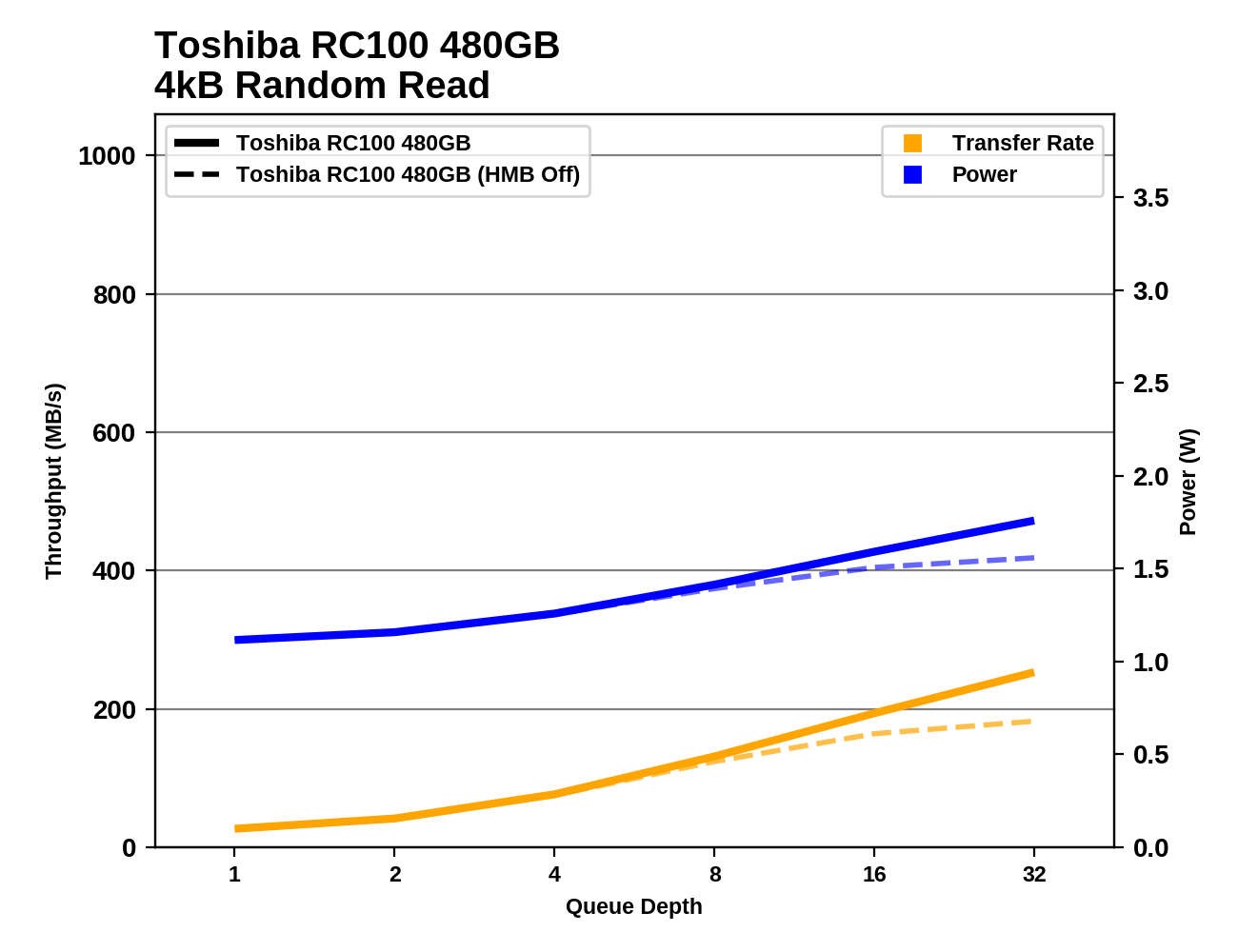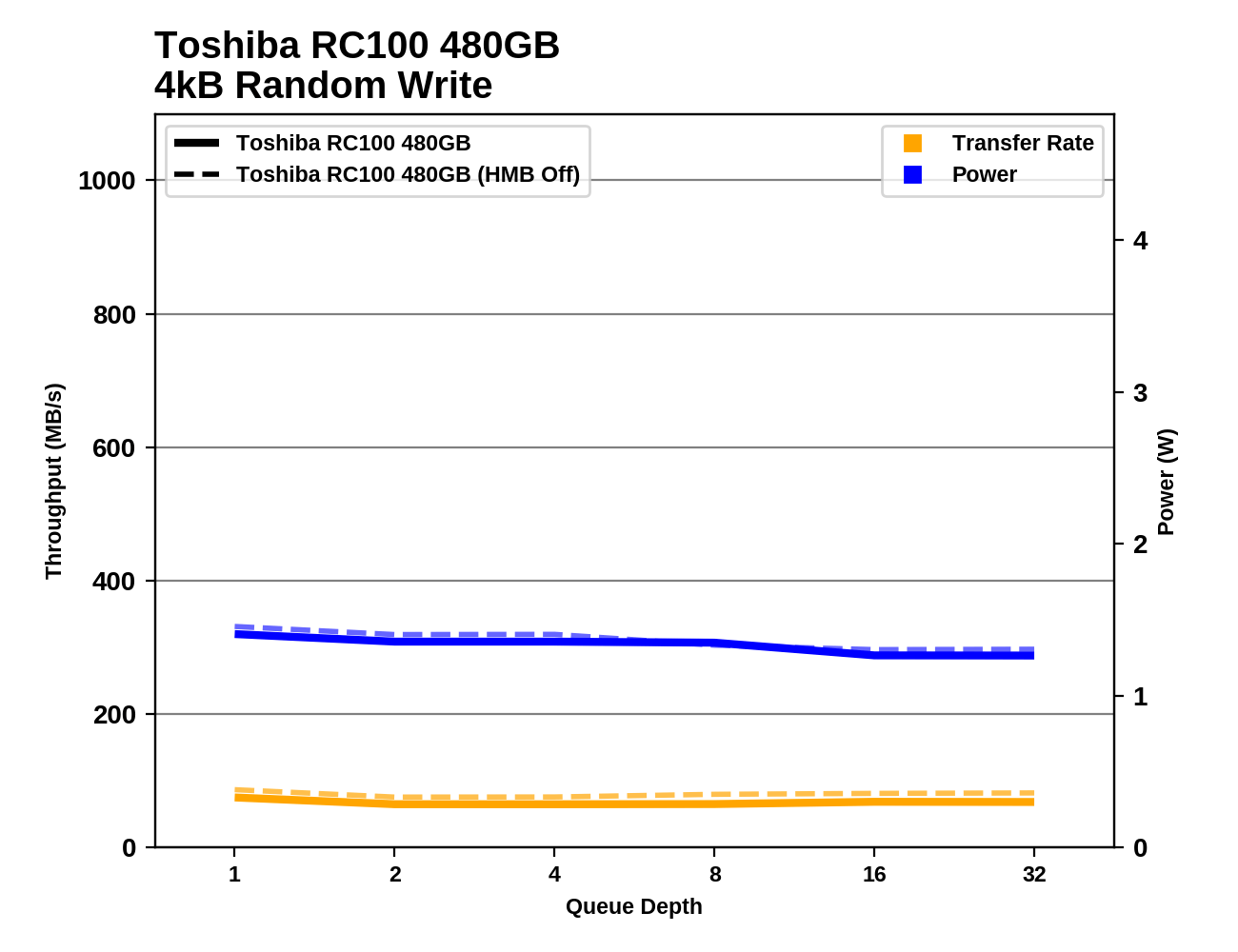The Toshiba RC100 SSD Review: Tiny Drive In A Big Market
by Billy Tallis on June 14, 2018 9:00 AM ESTRandom Read Performance
Our first test of random read performance uses very short bursts of operations issued one at a time with no queuing. The drives are given enough idle time between bursts to yield an overall duty cycle of 20%, so thermal throttling is impossible. Each burst consists of a total of 32MB of 4kB random reads, from a 16GB span of the disk. The total data read is 1GB.

The Toshiba RC100 surprises with excellent burst random read performance, and even when HMB is off it outperforms the other low-end NVMe SSDs we've tested.
Our sustained random read performance is similar to the random read test from our 2015 test suite: queue depths from 1 to 32 are tested, and the average performance and power efficiency across QD1, QD2 and QD4 are reported as the primary scores. Each queue depth is tested for one minute or 32GB of data transferred, whichever is shorter. After each queue depth is tested, the drive is given up to one minute to cool off so that the higher queue depths are unlikely to be affected by accumulated heat build-up. The individual read operations are again 4kB, and cover a 64GB span of the drive.

On the longer random read test that covers a broader span of the drive than HMB can help with, the Toshiba RC100's scores are unsurprisingly in last place among NVMe drives, but it's not too far behind the Intel 600p.
 |
|||||||||
| Power Efficiency in MB/s/W | Average Power in W | ||||||||
The RC100 clearly uses less power during random reads than any other NVMe SSD we've tested, but the poor performance when reading from a wide span of the drive means the efficiency is just a bit below average.
 |
|||||||||
For the larger RC100, the HMB feature has a fairly large impact on random read performance at high queue depths even though the HMB cache is too small to completely handle this workload. At low queue depths and for the smaller 240GB model at any queue depth, HMB has minimal impact on random read performance.
Random Write Performance
Our test of random write burst performance is structured similarly to the random read burst test, but each burst is only 4MB and the total test length is 128MB. The 4kB random write operations are distributed over a 16GB span of the drive, and the operations are issued one at a time with no queuing.

With HMB enabled, the burst random write performance of the Toshiba RC100 is decent, but without HMB it can't beat a mainstream SATA drive.
As with the sustained random read test, our sustained 4kB random write test runs for up to one minute or 32GB per queue depth, covering a 64GB span of the drive and giving the drive up to 1 minute of idle time between queue depths to allow for write caches to be flushed and for the drive to cool down.

Once again, the large working set size of this test compared to the small host buffer size used by the RC100 condemns the drive to last place. The margin between the RC100 and the next-slowest NVMe drive is much larger than it was for the sustained random read test. HMB actually slightly hurts performance here.
 |
|||||||||
| Power Efficiency in MB/s/W | Average Power in W | ||||||||
Power consumption is slightly higher for random writes than for random reads, but still well below the other NVMe SSDs. The performance is low enough that the power efficiency score for the RC100 is worse than all the competition.
 |
|||||||||
Random write performance from the RC100 is low at any queue depth. The drive doesn't have enough memory to perform effective write combining and caching under this sustained load, while high-end drives usually manage to significantly improve performance when working with a large queue of write operations.










62 Comments
View All Comments
MadAd - Saturday, June 23, 2018 - link
+1Anyone can review a flagship release, this is real tech reporting.
Calin - Thursday, June 14, 2018 - link
Yes, more people care about the low-mid end of the market than about the very high end - the M.2 2242 has multiple advantages (compact, doesn't need a 2.5 or 3.5 inch case location, doesn't need power cable, low power. Plenty of people will pay more for that, if the performance is equivalent (just as plenty of people pay more for pretty lights when the performance is equivalent, or pay more for a quiter component, or ...).So, while I'm not interested in M2 drives, thank you for the article :)
gnufied - Thursday, June 14, 2018 - link
Actually I have been looking for a decent 2242 SSD since forever. My thinkpad T450s has a 2242 slot and we have very little options.Having said all this, I dunno if this is comptaible with thinkpad's 2242 slot.
timecop1818 - Thursday, June 14, 2018 - link
most likely not, as that slot is probably for USB-based LTE modem or similar device. M.2 spec does provide for USB connectivity on A, B and E keyed cards/sockets.gnufied - Thursday, June 14, 2018 - link
The 2242 slot defenitely can be used for M.2 SSDs. I am currently using https://www.amazon.com/gp/product/B012ASBZEO/ref=o... SSD with my thinkpad and it works.Reading through R100 review does not fill me with joy though. This NVMe disk does not even look better than M500.. :(
Targon - Thursday, June 14, 2018 - link
M.2 has different flavors, and depending on the slot and device you plug into it, may use a SATA connection rather than NVMe with the dedicated PCI Express lanes. The 2242 is a measure of width and length, NOT the interface. An obvious way to tell is that if you have two notches on the connector, you are not looking at a NVMe connection, while the single notch will support the PCI Express lanes. At least, that is typically what is going on. With only two PCI Express lanes, without investigating, I suppose the two notches might still give you some NVMe, but I wouldn't be sure about that.Kwarkon - Friday, June 15, 2018 - link
There are NVME drives with two notches (M+B), but this keying is limited to only 2 PCIe lines.Jorgp2 - Thursday, June 14, 2018 - link
I already ordered one, I'll try to send you a PM if it worksgnufied - Thursday, June 14, 2018 - link
Nice. thank you. also do a crystal mark or something while you are at it. :-)close - Thursday, June 14, 2018 - link
Because it's less than half the price so it has a better chance of ending up in a "regular machine" than the 970 Pro. Reviews for halo products are great but what do you think most people will have a $350 SSD or a $150 one?